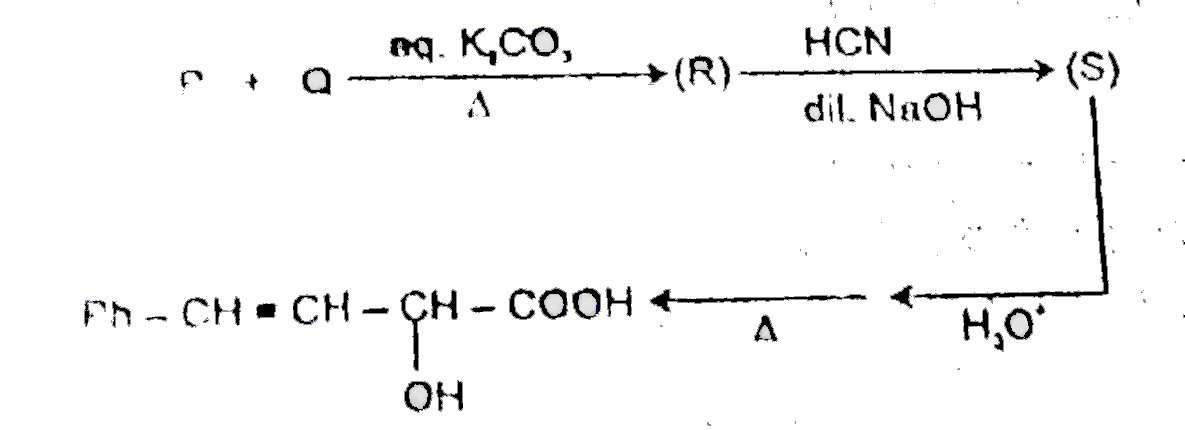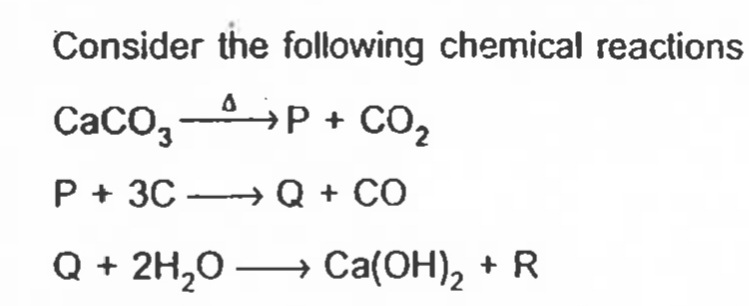Consider following reaction:
Cl2(g)+H2OR.T.−−→P+Q
If molecular weight of P is less than Q then incorrect statement is:
On warming 'P' can form deep red coloured vapours with CrO3
Q' exhibits bleaching property
MnO2 can change 'P' into Cl2 gas on warming
P' reacts with H2S gas while 'Q' does not
The correct Answer is:D
To solve the given question, we need to analyze the reaction between chlorine gas (Cl₂) and water (H₂O) at room temperature, which produces two products, P and Q. We are also given that the molecular weight of P is less than that of Q. Let's break down the solution step by step.
Step 1: Identify the Reaction
The reaction is:
Cl2(g)+H2O→P+Q
Step 2: Determine the Products
When chlorine gas reacts with water, the products formed are hydrochloric acid (HCl) and hypochlorous acid (HOCl):
Cl2+H2O→HCl+HOCl
Step 3: Assign P and Q
According to the problem, we need to assign P and Q based on the molecular weights:
- Let P = HCl (molecular weight = 36.46 g/mol)
- Let Q = HOCl (molecular weight = 52.46 g/mol)
Since the molecular weight of P (HCl) is less than that of Q (HOCl), this assignment is consistent with the given information.
Step 4: Analyze the Statements
Now we need to evaluate the statements provided in the question to find the incorrect one.
1. Statement A: "On warming, P can form deep red colored vapors with CrO₃."
- Analysis: HCl does not form deep red vapors with CrO₃; this statement is incorrect.
2. Statement B: "Q exhibits bleaching property."
- Analysis: HOCl is known to have bleaching properties. This statement is correct.
3. Statement C: "MnO₂ can change P into Cl₂ gas on burning."
- Analysis: HCl can react with MnO₂ to produce Cl₂ gas. This statement is correct.
4. Statement D: "P reacts with H₂S gas while Q does not."
- Analysis: HCl does not react with H₂S, while HOCl can react with H₂S. This statement is incorrect.
Step 5: Conclusion
Based on the analysis, the incorrect statement is:
- Statement A: "On warming, P can form deep red colored vapors with CrO₃."
Thus, the answer is A.
The reaction is:
Cl2(g)+H2O→P+Q
When chlorine gas reacts with water, the products formed are hydrochloric acid (HCl) and hypochlorous acid (HOCl):
Cl2+H2O→HCl+HOCl
According to the problem, we need to assign P and Q based on the molecular weights:
- Let P = HCl (molecular weight = 36.46 g/mol)
- Let Q = HOCl (molecular weight = 52.46 g/mol)
Now we need to evaluate the statements provided in the question to find the incorrect one.
- Analysis: HCl does not form deep red vapors with CrO₃; this statement is incorrect.
- Analysis: HOCl is known to have bleaching properties. This statement is correct.
- Analysis: HCl can react with MnO₂ to produce Cl₂ gas. This statement is correct.
- Analysis: HCl does not react with H₂S, while HOCl can react with H₂S. This statement is incorrect.
Based on the analysis, the incorrect statement is:
- Statement A: "On warming, P can form deep red colored vapors with CrO₃."
Topper's Solved these Questions
- TYPES OF REACTIONSBOOK - VK JAISWAL ENGLISHCHAPTER - TYPES OF REACTIONSEXERCISE - LEVEL 3
44 Videos
- TYPES OF REACTIONSBOOK - VK JAISWAL ENGLISHCHAPTER - TYPES OF REACTIONSEXERCISE - ONE OR MORE ANSWERS IS/ARE CORRECT
40 Videos
- TYPES OF REACTIONSBOOK - VK JAISWAL ENGLISHCHAPTER - TYPES OF REACTIONSEXERCISE - SUBJECTIVE PROBLEMS
42 Videos
- s-BLOCK ELEMENTSBOOK - VK JAISWAL ENGLISHCHAPTER - s-BLOCK ELEMENTSEXERCISE - SUBJECTIVE PROBLEMS
2 Videos
Similar Questions
Knowledge Check
In the following reaction:
2NO(g)+Cl2(g)⇔2NOCl(g)
it is observed that equilibrium is not attained and the rate of forward reaction is greater than rate of backward reaction. Which of the following is true for the reaction ? (A) K p = Q p (B) Q p > K p (C) Q p < K p (D) Q p = 0AKp=QpBQp>KpCQp<KpDQp=0
Consider the following reaction , the compounds P and Q are respectively

View SolutionConsider the following reaction sequence

The compounds P and Q are :
View Solution2P−H2O−−−→Q−[O]−−−→R
If P is parent phosphoric acid then according to given information the correct statement is/are:
View SolutionThe difference of molecular weights of the major products P and Q form at the following reactions is

View SolutionConsider the following reactions:
Fe2+excessCN−−−−−−−→P,
Fe3+excessCN−−−−−−−→Q,
Which of the following is correct about P and Q ?
View SolutionConsider the following statements. p: Hari is clever. q: shyam is fool. r: Shyam is honest. The negation of statement Hari is clever & Shyam is dishonest if and only if shyam is fool is expressed. As.... (1) ~p∧(q⇔~r) (2) ~(q⇔(p∧~r)) (3) ~q⇔(~p∧r) (4)~(p∧~r) (5) ~(p∧r)
View SolutionConsider the following chemical reactions,Compound P,Q, and R respectively are

View Solution
